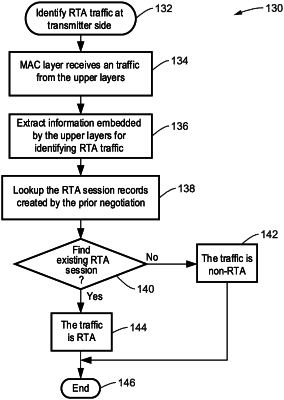| CPC H04W 74/0875 (2013.01) [H04W 74/0808 (2013.01); H04W 84/12 (2013.01)] | 4 Claims |

|
1. An apparatus for wireless communication in a network, the apparatus comprising:
(a) a wireless communication circuit configured, as a station under an IEEE 802.11 communications protocol supporting carrier sense multiple access/collision avoidance (CSMA/CA) and providing a lower latency capability for real-time application (RTA) traffic, for wirelessly communicating over at least one channel with at least one other wireless station on a wireless local area network (WLAN) in its reception area;
(b) a processor coupled to the station configured for operating on the WLAN;
(c) a non-transitory memory storing instructions executable by the processor; and
(d) wherein said instructions, when executed by the processor, perform steps of the communications protocol comprising:
(i) operating said wireless communication circuit as a WLAN station under CSMA/CA for communicating non-real time (non-RTA) packets between stations which contend for channel access;
(ii) distinguishing RTA packets from non-RTA packets at the station's media access control (MAC) layer, which extracts information when receiving traffic from an upper layer and compares it with RTA session records created during RTA stream negotiations to determine if the packets are RTA packets;
(iii) scheduling channel time for transmitting RTA traffic based on expected RTA packet arrival time as determined at the MAC layer;
(iv) sharing scheduled channel time information with neighboring wireless stations;
(v) adjusting scheduled channel time based on the scheduled channel time of at least one of its neighboring wireless stations toward preventing channel contention collisions when multiple RTA traffics are contending for the channel;
(vi) occupying the channel before the RTA packet arrives; and
(vii) transmitting the RTA packet.
|